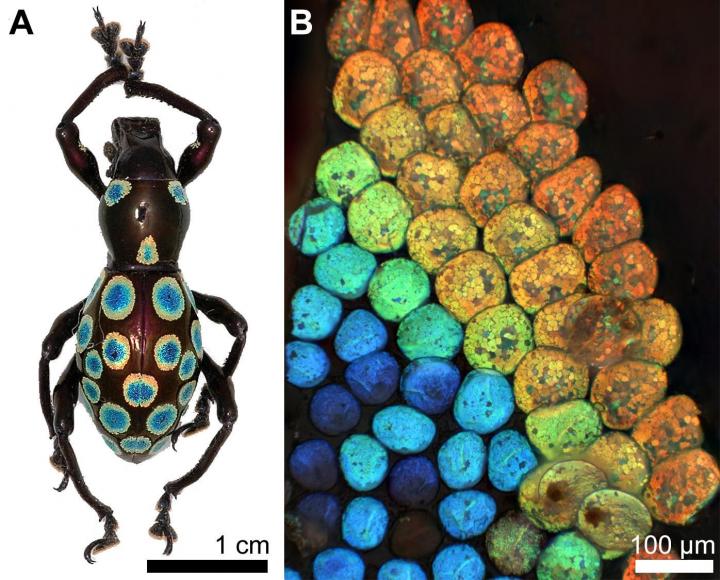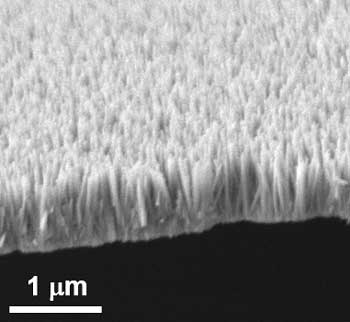From YouTube, Heijmans NV Published on Nov 12, 2014 Inspired by Vincent van Gogh’s work, the cycle path combines innovation and design with cultural heritage and tourism. The Van Gogh-Roosegaarde cycle path is being constructed by Heijmans from a design by Daan Roosegaarde and forms part of the Van Gogh cycle route in Brabant.
According to other sources, the path was inspired by van Gogh’s ‘Starry Night’. From a November 21, 2014 article by Elizabeth Montalbano for Design News (Note: A link has been removed),
The Dutch are known for their love of bicycling, and they’ve also long been early adopters of green-energy and smart-city technologies. So it seems fitting that a town in which painter Vincent van Gogh once lived has given him a very Dutch-like tribute — a bike path lit by a special smart paint in the style of the artist’s “Starry Night” painting.
Designed by artist Daan Roosegaarde of Studio Roosegaarde, the van Gogh-Roosegaarde bike path — in the Dutch town of Nuenen en Eindhoven, where van Gogh lived from 1883-1885 — is a kilometer long and features technologies developed as part of the Smart Highway project, a joint venture of the studio and Dutch infrastructure company Heijmans.
…
A team of 12 designers and engineers worked on the project for eight months, while site production took 10 days. The opening of the path marked the official launch of the international van Gogh 2015 year.
The path uses stones painted with a smart coating that charges by the heat of the sun during the day and then glow at night for up to eight hours. When there is not enough sunlight during the day to charge the stones, the path can draw electricity from a solar panel installed nearby. There are also LEDs in the path that provides lighting.
…
How does the technology work?
Despite my best efforts, I never did unearth a good technical explanation. There is some sort of photoluminescent powder or paint. I vote for a powder that’s been emulsified in a paint/coating. material. Somehow, this material is charged by sunlight and then at night glows with the help of a solar panel and light-emitting diodes (LEDs).
Here’s the clearest explanation I found; it’s from Dan Howarth’s November 12, 2014 article for dezeen.com (Note: A link has been removed), ,
…
The surface of the Van Gogh-Roosegaarde Bicycle Path is coated with a special paint that uses energy gathered during the day to glow after dark.
…
[Daan] Roosegaarde told Dezeen that this method of illumination is “more gentle to the eye and surrounding nature” that other lighting infrastructure, and creates a “connection with cultural history”.A nearby solar panel is used to generate power to illuminate the coated surface, which was developed with infrastructure firm Heijmans. LEDs along the side of certain curves in the path cast extra light, meaning the path will still be partially lit if the weather has been too cloudy for the panel to charge the surface to its full brightness.
“It’s a new total system that is self-sufficient and practical, and just incredibly poetic,” said Roosegaarde.
…
Lily Hay Newman’s November 14, 2014 article for Slate.com succinctly sums up the technical aspects,
…
The path is coated in photoluminescent paint that’s also embedded with small LEDs powered by nearby solar panels. The path essentially charges all day so that it can glow during the night, and it also has backup power in case it’s overcast.
…
This October 30, 2012 article by Liat Clark for Wired.com provides a bit more detail about the powder/paint as Clark delves into the Roosegaarde Studo’s Smart Highway project (the cycle path made use of the same technology) ,
…
The studio has developed a photo-luminising powder that will replace road markings – it charges up in sunlight, giving it up to 10 hours of glow-in-the-dark time come nightfall. “It’s like the glow in the dark paint you and I had when we were children,” designer Roosegaarde explained, “but we teamed up with a paint manufacturer and pushed the development. Now, it’s almost radioactive“. [perhaps not the wisest choice of hyperbole]
Special paint will also be used to paint markers like snowflakes across the road’s surface – when temperatures fall to a certain point, these images will become visible, indicating that the surface will likely be slippery. Roosegaarde says this technology has been around for years, on things like baby food – the studio has just upscaled it.
…
Not everyone is in love
Shaunacy Ferro’s July 26, 2017 article for dentalfloss.com highlights a glow-in-the-dark path project for Singapore and a little criticism (Note: Links have been removed),
Glow-in-the-dark materials are no longer for toys. Photoluminescence can help cities feel safer at night, whether it’s part of a mural, a bike lane, or a highway. Glow-in-the-dark paths have been tested in several European cities (the above is a Van Gogh-inspired bike path by the Dutch artist Daan Roosegaarde) and in Texas, but now, the technology may be coming to Singapore. The city-state is currently developing a 15-mile greenway called the Rail Corridor, and it now has a glow-in-the-dark path, as Mashable reports.
The 328-foot stretch of glowing path is part of a test of multiple surface materials that might eventually be used throughout the park, depending on public opinion. In addition to the strontium aluminate-beaded [emphasis mine] path that glows at night, there are also three other 328-foot stretches of the path that are paved with fine gravel, cement aggregate, and part-grass/part-gravel. The glow-in-the-dark material embedded in the walkway absorbs UV light from the sun during the day and can emit light for up to eight hours once the sun goes down.
However, in practice, glow-in-the-dark paths can be less dazzling than they seem. [emphasis mine] Mashable’s reporter called the glowing effect on Singapore’s path “disappointingly feeble.” [emphasis mine] In 2014, a glowing highway-markings pilot by Studio Roosegaarde in the Netherlands revealed that the first road markings faded after exposure to heavy rains. [emphases mine] When it comes to glowing roads, the renderings tend to look better than the actual result, [emphasis mine] and there are still kinks to work out. (The studio worked the issue out eventually.) While a person walking or biking down Singapore’s glowing path might be able to tell that they were staying on the path better than if they were fumbling along dark pavement, it’s not the equivalent of a streetlight, for sure.
…
Ferro had reported earlier on Studio Roosegaarde’s Smart Highway project in an October 23, 2014 article for Fast Company where Ferro first mentioned the rain problem (Note: Links have been removed),
Glowing Lanes is a collaboration between Dutch engineering company Heijmans and Daan Roosegaarde, a tech-loving artist and designer whose previous work includes Intimacy 2.0, a dress that becomes transparent when the wearer gets aroused. The glow-in-the-dark lane markers are intended to increase road visibility in a more energy-efficient way than traditional street lighting. Photoluminescent paint charges during the day and slowly emits light over the course of eight hours during the evening.
After a few technical challenges (an early version of the markers didn’t fare so well in the rain), the final system has been installed, and according to Studio Roosegaarde, the kinks have been worked out, and initial reports of the paint fading were “overstated.” [emphases mine]
“This was part of any normal learning process,” according to an email from the studio’s PR, and “now the project is ‘matured.’”
But not to the point where it’s no longer a novelty. According to the email from Studio Roosegaarde, the glowing highway caused a minor traffic jam last night as people rushed to look at it.
…
… Roosegaarde has also been asked to create a smart highway design for Afsluitdijk–an almost 20-mile-long dike that connects North Holland to the province of Friesland across the water–and according to his studio, there are plans in the works to launch the glowing lanes in China and Japan as well.
…
Comments
In the following excerpt, there’s a reference to strontium aluminate-coated materials, given the interview which follows this section, the project in Singapore did not use the photoluminescent paint developed by Roosegaarde Studio. I found this paint reference in a July 26, 2017 article by Yi Shu Ng for Mashable (h/t Ferro’s July 26, 2017 article) which notes the product’s ubiquity,
…
The track glows because it’s got strontium aluminate compounds embedded in it — the chemical is commonly found in glow-in-the-dark products, which absorb ultraviolet light in the day, to emit luminescence at night.
…
There are some inconsistencies in the reporting about the number of hours, eight hours or 10 hours, the bicycle path or smart highway remains lit after being charged. Given that this was a newish technology being used in a new application, the rain problem and other technical glitches were to be expected. I wish the writer had been a little less dismissive and that the studio had been a little more forthcoming about how they solved the problems. In any case, I dug further and this is what I got.
Interview
I’m not sure who answered the questions but this comes direct from Studio Roosegaarde,
- Could you give me a capsule description of what’s happened since the path was opened in 2014/15? For example, How does the bike path look these days? Does it still glow? Don’t the bicycles on the path destroy the ‘Starry Night’ pattern over time? Do the stones have to be coated over and over again to maintain their solar charging capacities?
The Van Gogh Path is still working perfectly and is visited every night by couples, tourists and local people. The stones are inside the concrete so are still in place and will work for a minimum of 10 years. It is great to see we have created a place of wonder. It is the most published bicycle path in the world. We have even had children books published about it.
- Are there more bike paths like the Van Gogh Path in other parts of Holland and/or elsewhere?
No, this is the only one. There have been some copycats in other countries.The Smart Highway project is still growing, and our recent Gates of Light is the next step of poetic and energy-neutral landscapes like the Van Gogh Path: https://www.studioroosegaarde.net/project/gates-of-light
- How has your project evolved? And, have there been any unanticipated benefits and/or setbacks? Is there a change in the technology, I noticed you were investigating bioluminscence.
Yes, we are still developing new landscapes of the future. What we have learned from Van Gogh Path we have applied in new projects such as Glowing Nature: https://www.studioroosegaarde.net/project/glowing-nature We also do something new.
- I was struck by how gentle the lighting is. I understand there has been some criticism about how much light the path radiates and I’m wondering about your thoughts on that.
Yes, since the path is a nature protected environment, normal LED lighting was not allowed. So the light is gentle but still visible, and sustainable.There are some bad copy-cats using cheap materials which don’t work well, like the one in Singapore. But we are happy that our path is still working.
Thank you to the folks at Studio Roosegaarde for taking the time to provide this interview. Here are links to Studio Roosegaarde and their industrial partner, Heijmans.



